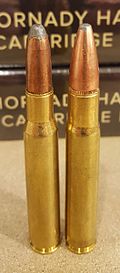.35 Whelen
| .35 Whelen | ||||||||||||||||||||
|---|---|---|---|---|---|---|---|---|---|---|---|---|---|---|---|---|---|---|---|---|

.30-06 Springfield parent cartridge on the left, .35 Whelen on the right
|
||||||||||||||||||||
| Type | Rifle | |||||||||||||||||||
| Place of origin | USA | |||||||||||||||||||
| Production history | ||||||||||||||||||||
| Designer | Col. Townsend Whelen / James Howe | |||||||||||||||||||
| Designed | 1922 | |||||||||||||||||||
| Specifications | ||||||||||||||||||||
| Parent case | .30-06 | |||||||||||||||||||
| Case type | Rimless, bottleneck | |||||||||||||||||||
| Bullet diameter | .358 in (9.1 mm) | |||||||||||||||||||
| Neck diameter | .385 in (9.8 mm) | |||||||||||||||||||
| Shoulder diameter | .441 in (11.2 mm) | |||||||||||||||||||
| Base diameter | .472 in (12.0 mm) | |||||||||||||||||||
| Rim diameter | .473 in (12.0 mm) | |||||||||||||||||||
| Case length | 2.494 in (63.3 mm) | |||||||||||||||||||
| Overall length | 3.340 in (84.8 mm) | |||||||||||||||||||
| Rifling twist | 1-16" | |||||||||||||||||||
| Primer type | Large rifle | |||||||||||||||||||
| Ballistic performance | ||||||||||||||||||||
|
||||||||||||||||||||
|
Test barrel length: 24 inches Source(s): Accurate Powder |
||||||||||||||||||||
The .35 Whelen is a powerful medium-bore rifle cartridge that does not require a magnum action or a magnum bolt-face. The parent of this cartridge is the .30-06 Springfield, which is necked-up to accept a bullet diameter of .358 in (9.1 mm). This cartridge is more powerful than its parent, especially in killing power on large game.
The .35 Whelen was developed in 1922 as a wildcat cartridge. Remington Arms Company standardized the cartridge as a regular commercial round and first made it available in the Remington model 700 Classic in 1988.
One version of its origin is that it was designed by Colonel Townsend Whelen when he was commanding officer of the Frankford Arsenal. In a 1923 issue of American Rifleman Col. Whelen refers to it as "the first cartridge that I designed" and states that, "Mr. James V. Howe undertook this work of making dies, reamers, chambering tools, and of chambering the rifles, all in accordance with my design." James V. Howe was a toolmaker at the Arsenal and later a founder of Griffin & Howe.
In his 1940 book The Hunting Rifle: Design, Selection, Ballistics, Marksmanship, Col. Whelen gives a different version of its origin after describing the .400 Whelen.
About the time we completed development of this cartridge, I went on a long hunting trip in the Northwest, and when I returned, Mr. Howe showed me another cartridge he had developed. The .30-06 case was necked to .35 caliber to use existing .35-caliber bullets. Mr. Howe asked my permission to call this cartridge the .35 Whelen, but he alone deserves credit for its development.
Suitable .358 in (9.1 mm) bullets range in weight from 150 to 300 grains (9.7 to 19.4 g). Using a 250-grain (16 g) bullet, the .35 Whelen will generate 3,500 ft·lbf (4,700 J) at the muzzle from a 24 in (61 cm) barrel.
The .35 Whelen is the ballistic twin of the .350 Remington Magnum. With the correct bullet choice this cartridge is suitable for virtually all thin-skinned large and dangerous game. The European designation for this cartridge would be 9 × 63 mm; with its wide bullet selection and high muzzle energy it is in the same echelon as the venerable 9.3×62mm.
...
Wikipedia
